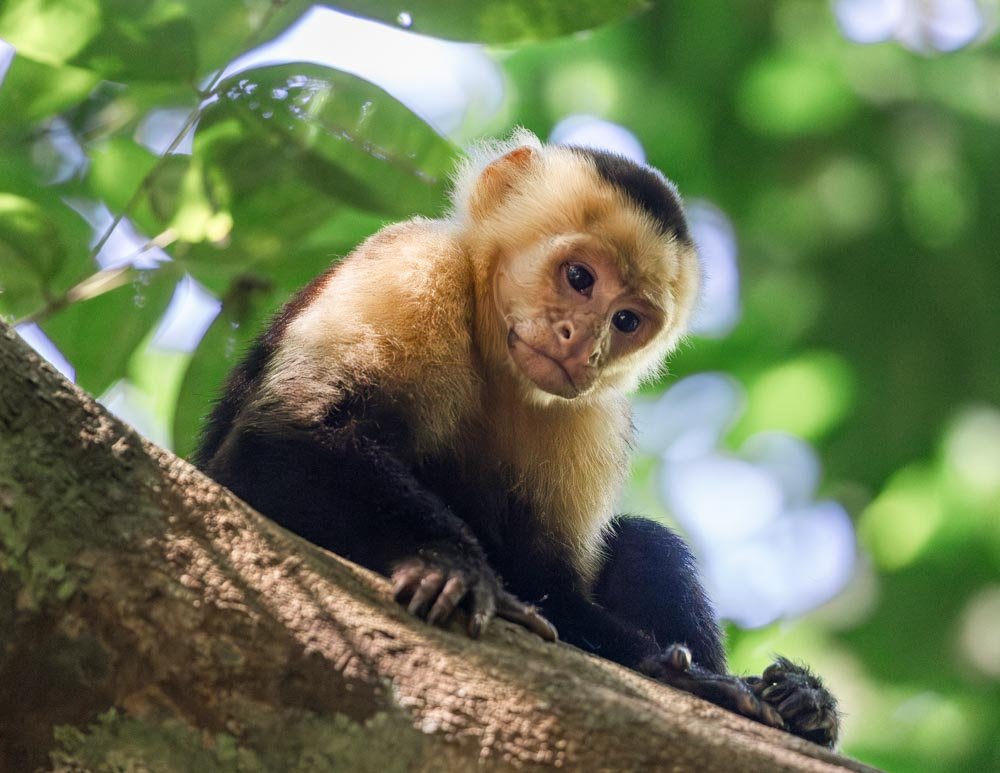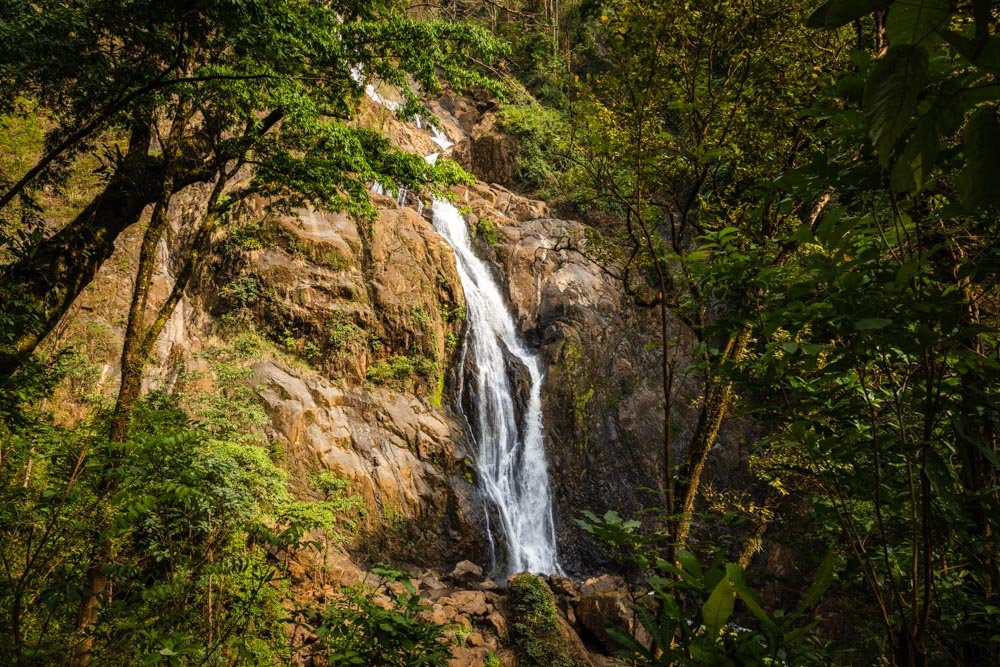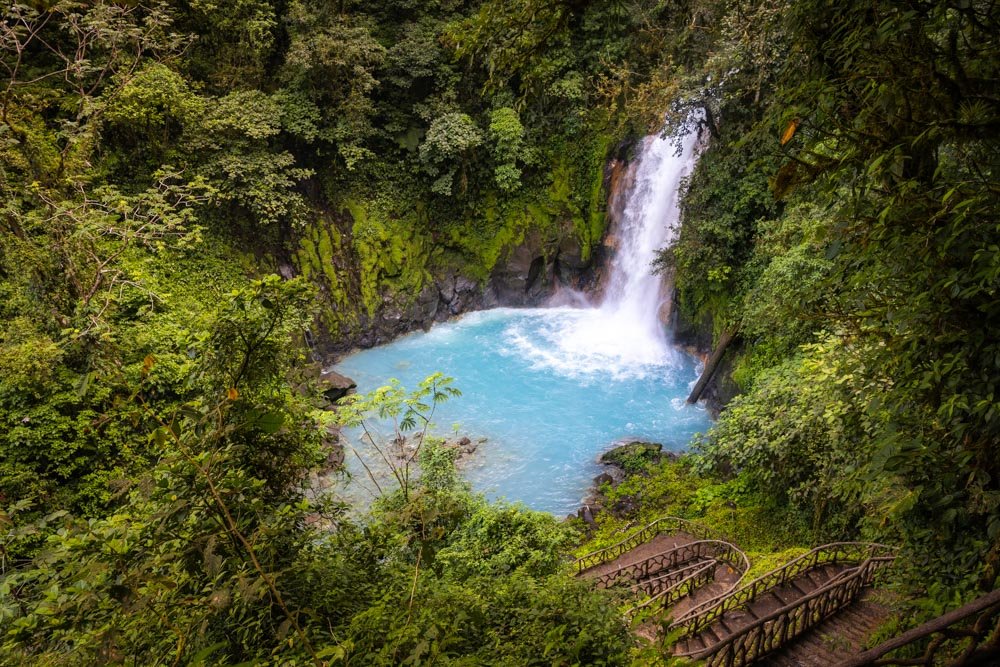The walk in the main sector of Tortuguero National Park is very easy and entirely flat - perfect for the tropical climate in this part of Costa Rica! You’ll start in a beautiful section of dense rainforest before the vegetation changes. We called it coastal rainforest - I’m not sure of the technical term for it - but either way it’s gorgeous. You’re bound to see Howler monkeys swinging through the trees, and Great green macaws soar overhead.
Once you reach the end of the track you can choose to return the same way, or head back along the wild and rugged black sand beach.
There are two sectors to Tortuguero National Park, the first is located right in the village itself, and the second is a short 20 minute boat ride away, and is known as Cerro Tortuguero. There is one walking trail in each sector and in this guide we’re covering the one in the village. If you’d like to know more about Cerro Tortuguero, we have you covered in this guide.
Here’s everything you need to know about the Tortuguero National Park walk.
The Tortuguero National Park Walk
The stats
Distance: 6km return
Elevation gain: 0m - completely flat
Difficulty: Easy
Know before you go
Although you don’t need a guide for this walk, you do need to have booked your national park ticket in advance. Even though there is a ticket office at the entry to the park, they check tickets, but don’t issue them. You book tickets on this website.
To book tickets with SINAC, you’ll need an account. Once you’ve set one up, you’ll then reach a page where on the sidebar you can click “buy” then “online reservation”. You’ll see a dropdown menu where you need to select “Parque Nacional Tortuguero - Sector Canales” (you can see an example below).
Unlike Manuel Antonio, you don’t have to pick an entry time as the ticket covers the whole day. Once you’ve navigated all of this, you’ll be emailed a ticket. Then all you need to do is show the confirmation at the ticket office, which has limited opening hours.
At time of writing the office is open between 6am and 7am, 7.30am and 12pm and 1pm and 3pm.
Although it says that the park closes at 4pm, we asked and were told we just had to finish the walk by 6pm. This fits with the time that all visitors must be off the beaches due to potentially disturbing nesting turtles.
The walk
From the ticket office you’ll head along the path signposted as The Jaguar Trail (El Jaguar terrestrial trail) and almost immediately enter the forest. This section of track is notorious for being very muddy, but we lucked out with bone dry conditions and no mud whatsoever. If it is really muddy, you can rent rubber boots from a number of shops/houses that line the path up towards the park entry gate.
This first part of the walk is where we saw the most wildlife. The canopy is teeming with Howler monkeys and we spent ages watching them swing between the trees - there was even a little baby, which made our day!
It’s not long before you leave the dense rainforest behind and start heading along a narrow path between the beach and forest.
You’ll soon come across a sign about jaguars and what to do if you encounter one! I’ve never actually heard of this happening, but it was interesting to read the protocols.
As the walk continues you’ll see lots of numbered trails leading left onto the beach. These are paths used by staff when checking on nesting turtles. You can cut onto the beach at any time if you’re after a bit of sea breeze.
Although the vegetation looks a little different to the first patch of forest you walked through, it’s still absolutely beautiful, and full of bird life. You can hear (and spot) Great green macaws snacking in the almond trees along much of this stretch of track, and their calls made for a wild atmosphere.
We also spotted huge numbers of Jesus Christ lizards who would run across the path in front of us. It’s not quite the same as seeing them walk on water, but still fun to watch.
You’ll also pass several piles of animal bones which people have stacked on tree branches - we think they were all from turtles, but aren’t 100% sure!
After 3km you’ll reach the sign indicating you’ve finished the trail and this is a nice point to head left onto the beach. There is plenty of driftwood to sit and relax on, and the beach feels a million miles from civilisation - in a good way!
Whilst the beaches of Tortuguero won’t win any prizes for being the most beautiful in Costa Rica - the sand is grey/black and the waves are too strong for swimming - this part of the beach in particular feels truly wild.
We were the only ones there and it was a great place to really soak up the feeling of being so remote. It also helped that we were walking in the late afternoon, so it was perfectly shady.
Sadly we did see the very intact remains of a huge leatherback turtle here, which was a shame as it was the only turtle we actually did see in Tortuguero!
Although leatherback nesting season was during our visit (April) you have to be extremely lucky to see one. Your best bet for witnessing turtles here is during the Green turtle nesting season, which runs from July to October.
Once you’ve relaxed on the beach you can choose either to walk back along the sand, take the same trail back through the forest, or a combination of the two using the numbered paths that cut regularly down to the beach.
Depending on when you’re walking, the beach is very exposed and the UV is extremely high in Tortuguero, it’s also harder to walk on sand than the easy dirt path, so we opted to retrace our steps whilst popping out to the beach every now and again for views.
Tortuguero National Park entry fee and opening times
The entry fee to this part of Tortuguero National Park is USD $15 plus tax for adult foreigners. If that feels a bit much, it’s worth checking out our guide to Cerro Tortuguero, which is in a different part of the park and only costs USD $2. You do need to catch a boat to and from this hiking trail, but it’s less than USD $4 return if you take the public ferry. The walk is really lovely and we saw even more wildlife in this section of the park.
As mentioned above, you do need to book your tickets online (for either part of the park). The ticket office where you have them checked for the main sector of the park has limited opening hours: 6am and 7am, 7.30am and 12pm and 1pm and 3pm. Despite the sign saying otherwise you are allowed to stay in the park until 6pm.
Technically speaking, you are meant to have a national park ticket if you are taking a canoe or kayak out on the canals (our favourite Tortuguero experience), so you’d want to do the walk on the same day in order that you don’t have to pay twice.
In reality, nobody checks whether you have a ticket on the boats and that’s been the case for both our visits. They don’t even have a park office at the boat dock, so really I wouldn’t worry about it.
Getting to Tortuguero National Park
Assuming you’re already in the village, you can just walk to the park entrance. It’s located at the southern end of the town and just a 5-10 minute walk from the main part of the village. They do have a boat dock, so if you’re staying out of town you could also take a boat directly there.
In terms of getting to Tortuguero itself, you can either take a boat or fly. There are no roads. We recommend taking the boat from Pavona because it’s basically like a scenic cruise in and of itself and it’s very cheap at just 8,000 colones (or $16 USD) return.
We spotted a crocodile, squirrel monkey, toucan, emerald basilisk and more on the journey.
Where we stayed in Tortuguero
Casa Chilamates 2.0
There was a lot to like about Casa Chilamates 2.0, but also some faults. Firstly, it’s a little house with a kitchen, a good shower, very powerful AC and a jungle setting, yet just a five minute walk from town. It was perfectly quiet at night apart from the sounds of the insects, which I personally love.
However, the curtains are very thin and the surrounding houses leave their porch lights on all night. If light bothers you, do not stay here. Also the AC unit is powerful, but very noisy and had a bright light which couldn’t be turned off. Personally I didn’t like these two things, but I am very sensitive when it comes to sleeping - not one previous reviewer had mentioned these points, so I guess I am alone in this!
If you don’t mind the light and AC noise, then you’re surrounded by Great green macaws and Howler monkeys in the nearby trees, which is very special.
You can check out more reviews and the prices on:
Mawamba Lodge
Due to the aforementioned sleeping issues, If I am lucky enough to return to Tortuguero for a third time I would stay at Mawamba Lodge. We actually walked past it on our night walk and it looked great. It was in a quiet location a bit away from town but if you don’t want to walk in, I believe you can catch the boat.
The rooms look lovely and each window is netted so you get the full breeze which is why I’d pick it as Tortuguero was insanely hot (although we were visiting in a rare patch with no rain!). They also have hammocks on the porch and there’s a pool.
You can check the reviews and prices on:
This post may contain affiliate links, meaning at no additional cost to you, we will earn a small commission if you click through and decide to make a purchase. This helps towards the costs of running our website. Thanks for your support.










































